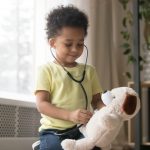 There are a few ailments in early childhood that are hard to avoid: Ear infections, the common cold, and of course, rashes. While most rashes are harmless and disappear over time without treatment, other rashes need more care and attention. If you’re concerned about your child’s rash or skin condition, it’s always best to contact your pediatrician to have it checked out as soon as possible.
There are a few ailments in early childhood that are hard to avoid: Ear infections, the common cold, and of course, rashes. While most rashes are harmless and disappear over time without treatment, other rashes need more care and attention. If you’re concerned about your child’s rash or skin condition, it’s always best to contact your pediatrician to have it checked out as soon as possible.
Highlights:
|
Here’s a list of common rashes found in babies and toddlers:
Baby Acne
Baby acne is also referred to as neonatal acne. About 20% of newborns experience this type of skin condition. It develops around a baby’s face or body, usually only in the first few months of life. Baby acne appears as small red or white pimples or bumps. In most cases, baby acne heals itself over time without treatment. There’s no clear answer as to what causes baby acne, but some doctors believe it could be due to mom’s hormones, which still circulate through the baby’s bloodstream after birth.
Diaper Rash
Diaper rashes are very common in babies. The rash appears as patches of redness or scaly skin around your baby’s bottom or genital area. Diaper rash thrives on moist, warm skin, so it’s important to keep the diaper area clean and dry. Diaper rash can also be caused by a reaction to new foods, irritation from urine or stool, or if a diaper is too tight.
Cradle Cap
Cradle cap is common in newborns. It’s often harmless and will go away within a few weeks or months. You’ll normally find cradle cap on the scalp and around the ears. In some cases, it can affect the area under the eyebrows or nose. Cradle cap appears as yellowish greasy or flaky patches around the baby’s scalp. Cradle cap is the baby version of seborrheic dermatitis, which is the same condition that causes dandruff in adults.
Drool Rash
If your baby is teething or just a frequent drooler, you might see slightly raised red patches or bumps around the mouth and cheeks. Drool rash is caused by the constant contact of saliva on the skin. It’s mostly harmless, but it can cause discomfort and irritability.
Hand, Foot, and Mouth Disease
Hand, foot, and mouth disease is often mild but very contagious. It can easily spread around childcare centers or preschools. It’s most commonly seen in children under the age of 5. Hand, foot, and mouth disease is a viral infection that causes rashes or blisters on the soles of the feet, palms, and inside the mouth. Symptoms of this infection also include a fever, tummy ache, or sore throat.
Eczema
Eczema can appear when babies are just a few months old or in early childhood. It normally becomes milder or will disappear completely by adulthood. Eczema makes the skin feel itchy and appears as patches of dry, red, or cracked skin. These rashes can appear on babies’ scalps or cheeks. With toddlers, it’s more common to see eczema in the creases of elbows or knees. Eczema can be caused by genes, issues with the immune system, sensitive skin, or environmental triggers like jewelry, soaps, or detergents.
Ringworm
Ringworm is a type of fungal infection on the skin that appears as a raised, red ring with a clear center. It begins as a red, scaly bump, but over time grows into a distinct circle. Ringworm is a mild rash, but can it can cause itchiness and stinging sensations. It’s also highly contagious and can spread through person-to-person contact or by sharing objects like combs, hats, or towels. Ringworm can also come from pets or other animals.
Heat Rash
Heat rash, also known as prickly heat, commonly appears around summertime. But remember, when toddlers are active, they sweat! That means they can get heat rash even when it’s not hot outside. When sweat ducts are blocked, moisture gets trapped in the skin, causing tiny red bumps that are filled with fluid. Children often experience heat rash around their necks, knee and elbow creases, inner thighs, and armpits. Heat rash usually clears up on its own within a week or so.
This list can help you identify different types of rashes and their causes, but remember to always talk to your pediatrician for an accurate diagnosis and treatment plan.








